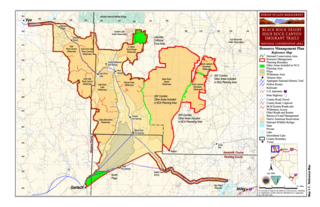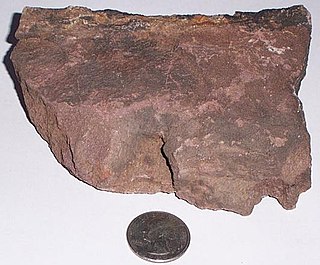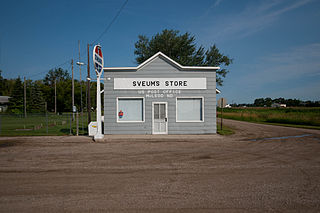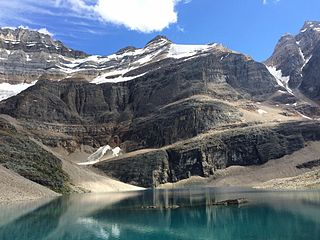Related Research Articles

The Brooks Range is a mountain range in far northern North America stretching some 700 miles (1,100 km) from west to east across northern Alaska into Canada's Yukon Territory. Reaching a peak elevation of 8,976 feet (2,736 m) on Mount Isto, the range is believed to be approximately 126 million years old.

The Black Rock Desert is a semi-arid region of lava beds and playa, or alkali flats, situated in the Black Rock Desert–High Rock Canyon Emigrant Trails National Conservation Area, a silt playa 100 miles (160 km) north of Reno, Nevada that encompasses more than 300,000 acres (120,000 ha) of land and contains more than 120 miles (200 km) of historic trails. It is in the northern Nevada section of the Great Basin with a lakebed that is a dry remnant of Pleistocene Lake Lahontan.

The lithology of a rock unit is a description of its physical characteristics visible at outcrop, in hand or core samples, or with low magnification microscopy. Physical characteristics include colour, texture, grain size, and composition. Lithology may refer to either a detailed description of these characteristics, or a summary of the gross physical character of a rock. Examples of lithologies in the second sense include sandstone, slate, basalt, or limestone.

The New Madrid Seismic Zone, sometimes called the New Madrid Fault Line, is a major seismic zone and a prolific source of intraplate earthquakes in the Southern and Midwestern United States, stretching to the southwest from New Madrid, Missouri.
An asteroid spectral type is assigned to asteroids based on their emission spectrum, color, and sometimes albedo. These types are thought to correspond to an asteroid's surface composition. For small bodies that are not internally differentiated, the surface and internal compositions are presumably similar, while large bodies such as Ceres and Vesta are known to have internal structure. Over the years, there has been a number of surveys that resulted in a set of different taxonomic systems such as the Tholen, SMASS and Bus–DeMeo classifications.

The Vermilion Range is a mountain range of the Canadian Rockies, in Banff National Park, Canada. The range is east of the Sawback Range and west of the Bare and Palliser Ranges.

Manning is a small town in, and the county seat of, Dunn County, North Dakota, United States. Manning was founded in 1908 to serve as the seat of Dunn County, itself organized that year. Its population was not reported in the 2000 Census, but was included in the 2010 Census, where a population of 74 was given. Its ZIP Code is 58642.

The Silurian Bloomsburg Formation is a mapped bedrock unit in Pennsylvania, New Jersey, New York and Maryland. It is named for the town of Bloomsburg, Pennsylvania in which it was first described. The Bloomsburg marked the first occurrence of red sedimentary rocks in the Appalachian Basin.
Torbanite, also known as boghead coal or channel coal, is a variety of fine-grained black oil shale. It usually occurs as lenticular masses, often associated with deposits of Permian coals. Torbanite is classified as lacustrine type oil shale.
Oil shale reserves refers to oil shale resources that are economically recoverable under current economic conditions and technological abilities. Oil shale deposits range from small presently economically unrecoverable to large potentially recoverable resources. Defining oil shale reserves is difficult, as the chemical composition of different oil shales, as well as their kerogen content and extraction technologies, vary significantly. The economic feasibility of oil shale extraction is highly dependent on the price of conventional oil; if the price of crude oil per barrel is less than the production price per barrel of oil shale, it is uneconomic.

The Kuiper quadrangle, located in a heavily cratered region of Mercury, includes the young, 55-km-diameter crater Kuiper, which has the highest albedo recorded on the planet, and the small crater Hun Kal, which is the principal reference point for Mercurian longitude. Impact craters and basins, their numerous secondary craters, and heavily to lightly cratered plains are the characteristic landforms of the region. At least six multiringed basins ranging from 150 km to 440 km in diameter are present. Inasmuch as multiringed basins occur widely on that part of Mercury photographed by Mariner 10, as well as on the Moon and Mars, they offer a potentially valuable basis for comparison between these planetary bodies.

McLeod is a census designated place in eastern Ransom County, North Dakota, United States. An unincorporated community, it was designated as part of the U.S. Census Bureau's Participant Statistical Areas Program on March 31, 2010. It was not counted separately during the 2000 Census, but was included in the 2010 Census, where its population was reported to be 27.

Menoken is a census-designated place (CDP) in southwestern Burleigh County, North Dakota, United States. It was designated as part of the U.S. Census Bureau's Participant Statistical Areas Program on June 10, 2010. It was not counted separately during the 2000 Census, but was included in the 2010 Census, where a population of 70 was reported.

The Marcellus Formation or the Marcellus Shale is a Middle Devonian age unit of sedimentary rock found in eastern North America. Named for a distinctive outcrop near the village of Marcellus, New York, in the United States, it extends throughout much of the Appalachian Basin.
Lamosite is an olive-gray brown or dark gray to brownish black lacustrine-type oil shale, in which the chief organic constituent is lamalginite derived from lacustrine planktonic algae. In minor scale it also consists of vitrinite, inertinite, telalginite, and bitumen.
Marinite is a gray to dark-gray or black oil shale of marine origin in which the chief organic components are lamalginite and bituminite derived from marine phytoplankton, with varied admixtures of bitumen, telalginite and vitrinite. Marinite deposits are the most abundant oil-shale deposits. They are generally widespread but at the same time they are relatively thin and often of restricted economic importance. Typical environments for marinite deposits are found in epeiric seas.
Lamalginite is a structured organic matter (alginite) in sapropel, composed of thin-walled colonial or unicellular algae that occur as distinct laminae, cryptically interbedded with mineral matter. It displays few or no recognisable biologic structures. Lamalginite fluoresce brightly in shades of yellow under blue/ultraviolet light. The term of lamalginite was introduced by Adrian C. Hutton of the University of Wollongong.

Mount Rainier, also known as Tahoma, Tacoma or Tacobet, is a large active stratovolcano in the Cascade Range of the Pacific Northwest, located in Mount Rainier National Park about 59 miles (95 km) south-southeast of Seattle. With a summit elevation of 14,411 ft (4,392 m), it is the highest mountain in the U.S. state of Washington and the Cascade Range, the most topographically prominent mountain in the contiguous United States, and the tallest in the Cascade Volcanic Arc.

Glacier Peak is located on the border of Alberta and British Columbia in the Canadian Rockies. It was named in 1894 by Samuel E.S. Allen in reference to the glacier on the northern side of the mountain.
The Oriskany Sandstone is a Middle Devonian age unit of sedimentary rock found in eastern North America. The type locality of the unit is located at Oriskany Falls in New York. The Oriskany Sandstone extends throughout much of the Appalachian Basin.
References
- ↑ Dyni, John R. (2006). "Geology and resources of some world oil-shale deposits. Scientific Investigations Report 2005–5294" (PDF). U.S. Department of the Interior. U.S. Geological Survey. Retrieved 2008-07-17.
- ↑ Hallsworth, C R; Knox, R W O’B (1999). "BGS Rock Classification Scheme. Volume 3. Classification of sediments and sedimentary rocks. Research Report, RR 99–03" (PDF). British Geological Survey. Retrieved 2008-07-17.